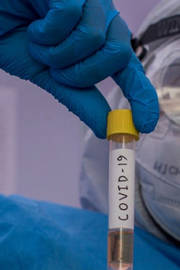
LIQUID AID
Posted 24 Apr 2020 | Source: THE WEEK
LIQUID AID
Convalescent plasma from a recovered Covid-19 patient at the Central Seattle Donor Center of Bloodworks Northwest in the US
ventilator assistance.
Experts say that plasma therapy could hold the key to limiting the complications associated with Covid-19 in critically ill patients. "Previous studies have shown a shorter hospital stay and lower mortality in patients treated with convalescent plasma therapy than those who were not treated with the same," says Dr Swati Rajagopal, consultant, infectious disease and travel medicine, Aster CMI Hospital, Bengaluru.
In India the therapy came into focus after Mohit Aggarwal (name changed), the first Indian patient to be treated with plasma therapy for Covid-19, showed positive outcomes. He was admitted to Max Healthcare in Delhi after he tested positive for Covid-19 0n April 4. He had fever and pneumonia with Type I respiratory failure. On April 8, he was put on ventilator support. However, there was no improvement in his condition. On April 14, he was administered plasma collected from a Covid-19 survivor. Plasma threrapy was used as an adjuvant treatment,and Aggarwal, 49, showed "progressive improvement" after receiving the treatment. He was weaned off the ventilator after four days. "In this patient, plasma therapy was used on compassionate grounds as a lifesaving treatment because the family requested for it, "says Dr sandeep Budhiraja, group medical director, Max Healthcare, adding that the treatment was given after due approval from the hospital ethics committee. Max Healthcare is now awaiting approval from the ICMR and theDCGI to take part in the clinical trial.
"The goal of the clinical trial is to find evidence of who is an appropriate plasma donor among those who have recovered and to see whether plasma therapy can be offered in future as an evidence-based treatment for Covid-19," says Dr Asha Kishore, director, Sree Chitra Tirunal Institute for Medical Sciences and Technology, Thiruvanthapuram. "It can also help decide the appropriate time [during the course of treatment] when the therapy can be given to prevent lung complications associated with the disease."
But how does plasma therapy work? "the concentration of antibodies specifically against the virus in the donor's blood binds with the virus when given to a recipient. It neutralise the virus in the recipient probably by preventing its entry into healthy cells and then multiplying within the cell," says Kishore. "Small studies from China indicate that it may help patients with pulmonary complications by reducing lung dysfuction and viral load."
In a pilot study in Wuhan, 10 severely ill patients who received plasma rich in antibodies from recovered patients were found to have a significant reduction in their viral load.
Encouraged by the outcomes, the UK and the US have launched clinical studies, too. " Recently, three Indian American patients (in Houston), who were critically ill, showed signs of recovery when they were transfused with the blood plasma of recovered patients," says Rajagopal.
Plasma therapy, unlike the current virus, is not novel; it was used during the 1918 Spanish flu pandemic and also showed promise in the treatment of Ebola, Influenza A (H1N1), SARS and MERS.
But plasma therapy is still not accepted as a widespread treatment option. Dr Mahesh Lakhe, consultant, internal medicine and infectious diseases, Columbia Asia Hospital, Pune, attribute it to numerous Practical hurdles. "Plasma therapy has its own challenges," he says. " You need to trace patients who have fully recovered from the disease. They should be aviremic (free from viruses in the blood plasma) and should show adequate protective antibody titer (concentration) before pooling out the plasma."
Previous studies have shown a shorter hospital stay ans lower mortality in patients treated with convalescent plasma therapy than those who were not treated with the same.
